How to make Korean Rice on stovetop! Cooking rice without a rice cooker can be a little overwhelming but it does make the most delicious rice. So follow my instructions and you will have the most fluffy and perfectly cooked Bap (rice) whether you are using a regular pot, stone pot or even rice cookers.
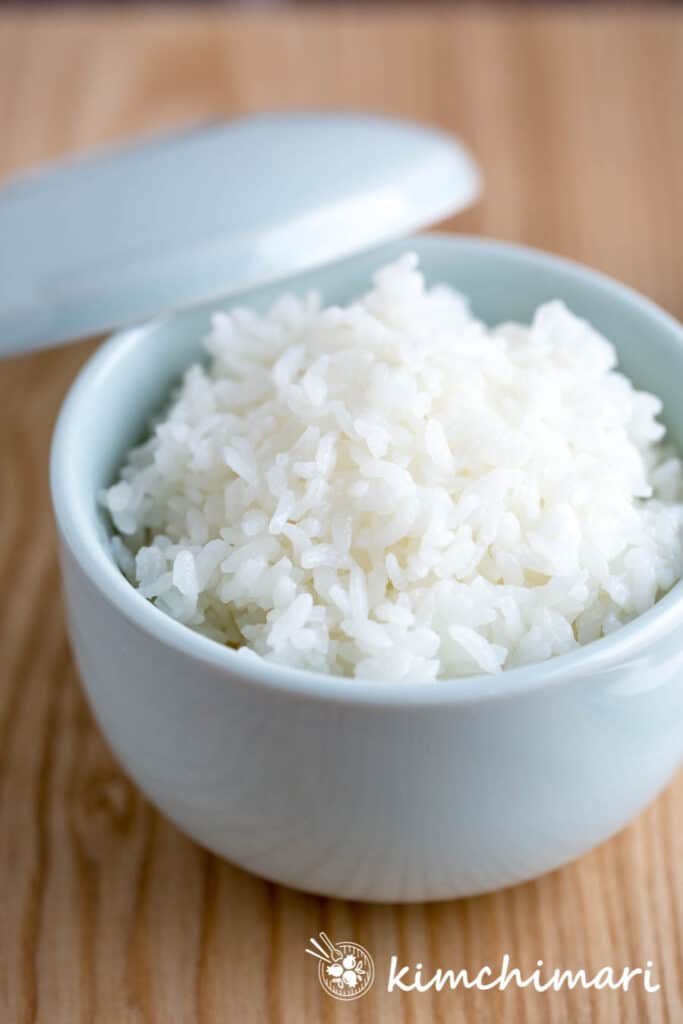
About Korean Rice
Korean Rice (Bap 밥) is a staple in Korean cuisine and so just like many obsess about good bread, Koreans obsess about making the perfect delicious bowl of rice. So when I was growing up, Koreans pretty much ate rice 3 meals a day. So a full Korean meal could not be had without rice unless you are eating noodles of course.
To read more on what a typical Korean meal is like, check out my Korean Cooking Guide where I have a Korean Food Explained section.
What kind of rice do Koreans eat?
Koreans eat short or medium-grain rice as the main staple and we call it Bap 밥. A Korean white rice is called Baekmi Bap 백미밥. In recent years, due to its high starch content, Koreans try to eat more multi-grain rice (japgokbap) or rice with beans added rather than pure white rice.
BTW, when I think of Baekmi Bap, I can’t help but remember my younger days in Korea in the 70’s. Would you believe that there were days when we were told NOT to eat 100% white rice because it was a luxury that the country could not afford? When so many Koreans were starving or not able to have rice…
History about Honsik 혼식
In the early 70s until 1976, the Korean government had a policy where everyone was asked to not eat 100% white rice but eat mixed multi-grain rice (Honsik) of 70% rice and 30% other grains such as barley, red azuki beans, sorghum and more. Check out my Japgokbap post for a recipe.
As one of the ways to enforce this policy, teachers would inspect students’ lunchboxes to make sure they brought a mixed rice lunch to school. If someone brought an all-white rice to school, oh boy.. they would get into trouble, their parents would be called in, etc..
You probably think this is way too much government control and I agree but just to put things into perspective, you have to understand what state the country was in at that time. Because Korea was still struggling after the war, there was not enough white rice to feed everyone. And so they came up with this so the demand for white rice would be less.
But still, I hated having to deal with the inspections, watching other kids get into trouble and seeing the teacher get mad at the whole class..etc.. because I am one of those that get stressed just watching other kids getting reprimanded by the teacher…
I just hate getting into trouble and be embarrassed.. so I loved living in Korea but my school memories are always dotted with these traumatic episodes of teachers punishing and yelling at students. Of course, all of that has changed and now some students actually abuse teachers instead.
The Honsik policy ended in 1977 with the improving of Korean economy and now, of course, the younger generations eat lot more breads and noodles than rice and Korea is now dealing with overabundance of rice. And the government is now trying to encourage products using rice as they now have an excess of rice.. who would have ever thought!? How the world changes with time..
What’s perfectly cooked white rice?
Just like some people like light coffee vs dark, some Koreans love a more moist, soft and sticky rice while some love a more dry and flaky rice.
JinBap 진밥 vs DoenBap 된밥
JinBap 진밥 refers to rice that’s quite moist when cooked and they are pretty sticky and very soft. Jilda 질다 is the adjective to describe anything that’s wet or liquidy. Koreans say ‘밥이 질다 Bap yi jilda’ to say that rice is too wet when there was too much water in cooking the rice. If you spoon the rice, it kind of mushes together into a blob.
DoenBap된밥 refers to rice that’s drier and the grains come out not as sticky and more easily separate into individual grains. We say ‘밥이 되다 Bap yi deoda’ in this case.
Each family or person tends to like different kinds of rice and sometimes it can even be a cause of conflict when 2 people get married and have different preferences. I’m lucky that my husband and I both like Deonbap. 💕
The perfect Bap I think is between the Doenbap and Jinbap but to me a little more to the Deonbap side – haha. Anyway, most people probably will like this kind of rice and I’m going to show you how to make this one. You can adjust the amount of water to your liking as you try it a few times.
Before we go on, I have one other quick bap related phrase to share.
Three Story Rice (Sam-cheung-bap 삼층밥) 😂🤣
Before the age of automatic rice cookers, Koreans made rice on the stove in a pot and before that it was made in Gamasot 가마솥 which is a huge iron cauldron with lids that hung inside a clay stove with a direct wooden fire burning underneath. The picture below has 2 Gamasot.
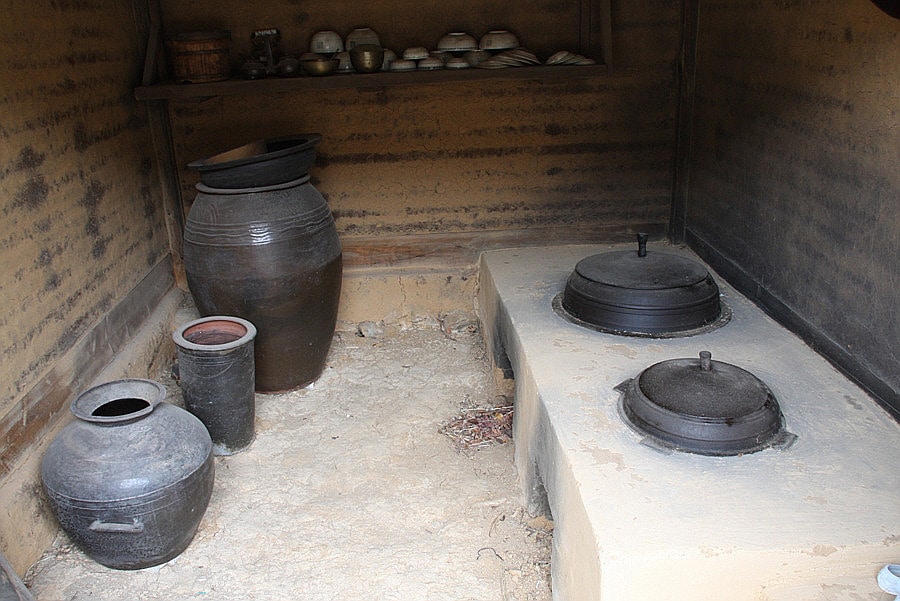
Anyway, Sam-cheung-bap refers to cooked rice with 3 different layers! 😝The bottom layer being burnt, the middle layer is barely cooked and the top layer of rice is partly uncooked. It happens when the rice is not cooked properly.
And once this happens, you can’t fix it.
It can also happen, if you are cooking rice in higher altitudes or if using thin lower-quality pots. Koreans who go camping in the mountains often end up with this 3 layer rice.. and whoever cooked it of course gets a lot of grief for it.. 😝 Anyway, when this happens, it’s bad.. because you kind of have wasted 2/3 of the rice.
TIP FROM JINJOO!
Chef’s Tips
- soaking rice is key to success for stove top – when cooking on the stove, it’s hard to make good rice without soaking.
- don’t soak rice for pressure rice cooker – soaking makes the rice too soft and mushy
- old rice 묵은 쌀 (that’s not a new crop 햅쌀 and is last year’s crop) may need to be soaked longer like an hour instead of 30 min.
- don’t let the water boil over too much – you will lose too much water which will end up in a dry, less tasty rice
- don’t open the lid while cooking Korean rice, unlike the common long grain rice cooking method where you stir the rice during cooking.
- a heavy, thick-bottomed pot should be used for best results
How much water for rice cooker and stovetop
For cooking short to medium grain rice
- Generally, you want to use about 1:1 or 1:1.1 (rice: water) ratio when cooking rice. So if you are cooking 1 cup of rice (dry), then add 1 cup water or 1 cup + 1 to 2 Tbs water.
- For stovetop, I like to use about 1- 2 Tbs extra water per 1 cup water just in case you lose some when it boils over.
- For rice cookers, esp. pressure cookers, you will not need the extra water as it loses very little moisture during cooking so 1:1 will work best WITHOUT soaking in advance.
- Depending on how fresh the rice is (new vs old crop), how you like your rice (dry or moist), you may find a different ratio to your liking. But start with 1:1 ratio and see how you like it.
Short Grain vs Medium Grain Rice
Honestly, before writing this post, I really did not pay much extra attention to the difference between short-grain rice vs medium grain rice because I just never really noticed a big difference and many other resources confirm that ‘short grain and medium grain’ rice is and can be used interchangeably.
But, you know me, for this post, I went out surveyed our markets, bought and cooked both short grain and medium grain rice and compared them. In the picture below, you can see RIGHT – short grain is a little shorter, wider and more opaque than medium grain on the LEFT.
Here are my observations –
- Many Korean Rice brands/packages really don’t differentiate (at least the ones sold in the US) between the two and often don’t even label specifically whether it’s short grain or medium grain. So it would be hard to even buy knowing what it is by reading the package. Most of the time, you will have to look at the rice grain close up to notice the difference.
- So Is there a taste difference? – Yes, but the difference is very slight. If you were to have the rice in a meal, you probably won’t notice the difference much. If you decided to compare the two cooked rice, like you were tasting wine 🤣, then the short-grain rice is slightly chewier and has a little sweeter aftertaste.
- Any other differences? – Short-grain rice will be a bit more sticky which means it will work better for Jumeokbap or Kimbap in terms of holding together.
Why should I make rice on stovetop when I have a rice cooker?
Here are some reasons why –
- you can save money by not buying fancy rice cookers
- making rice on stovetop (especially stone pot) results in yummier rice than rice cookers – according to a group of 400 Koreans randomly surveyed by after tasting rice cooked using different methods.
- making smaller amounts of rice is possible
- while some fancy rice cookers have functions to make Nurungji (burnt rice), stovetop rice naturally makes nurungji and you can easily make some by just cooking it a few minutes longer.
- it’s always good to know how to do this in case you have to travel, your electricity is down or in whatever situation where you can’t have a rice cooker.
How to cook Korean rice on Stovetop
do THIS with rice for all stovetop cooking
- Rinse rice at least 3 times. Add rice to a mixing bowl, add water and swirl the rice around for few seconds. Then drain away the liquid. Add clear water and repeat. We want to rinse the rice 3 times at least to remove as much dirt and arsenic from the rice. But note, rinsing it too harshly and too many times will also strip away good nutrients so it’s a balance.
- Let rice soak in water for 30 min (or longer is ok too). Add enough water so it’s at least 1/2 inch above the rice.
- Drain.
How to make Korean Rice on stove top in regular Pot
Freshly made rice on the stovetop is preferred by some over electric rice cookers in terms of taste and texture. My mother-in-law stopped using the electric rice cooker altogether few years ago because she said Naembi Bap 냄비밥 (pot rice) tasted much better.
But I know.. you can’t really beat the convenience of rice cookers. And I think perhaps it was partly due to the fact that she had an old rice cooker that was losing the rubber seal..
Anyway, if you have a thick-bottomed heavy pot, you can make delicious rice on the stove top. I used my all-clad 2 QT pot below and it works perfectly for 1 cup of rice.
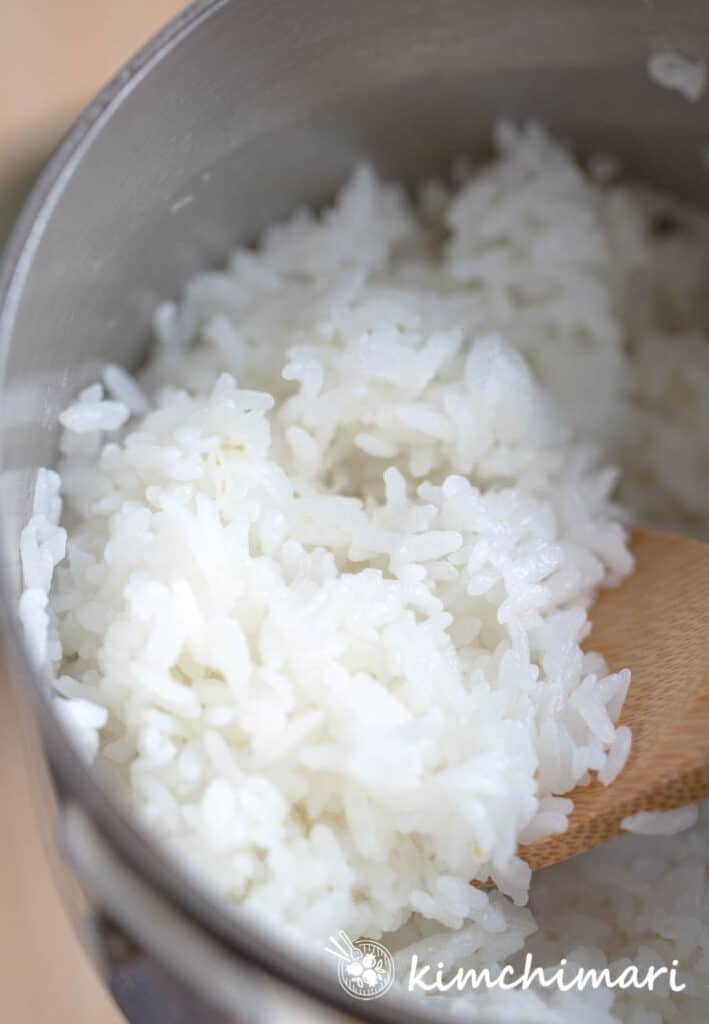
- Add soaked and drained rice in pot. For 1 cup rice (measured when dry), add 1 cup + 1 ~ 2 Tbs water to a stainless pot. Be sure to choose a pot that is deep enough so your water doesn’t boil over easily.
- Cover with the lid, turn on heat to medium-high and cook for 3 1/2 min to 4 min. It should not boil over if you stop here. If it boils over, immediately lower the heat to Low.
- Simmer for 15 – 17 min on Low heat. Depending on how soon you lowered the heat.
- Turn off heat and let it sit for 5 min. This will make a perfectly cooked rice with no burnt rice on the bottom.
How to make Korean Rice in Dolsot (Stone Pot)
Koreans just love ❤️ rice that’s cooked in Dolsot 돌솥 (aka Gop-dolsot 곱돌솥). Dol 돌 means Stone and Sot 솥 means pot and it is a stone pot carved from Gop-dol (agalmatolite). The stone pot is great because it heats evenly, keeps warm and the heavy lid keeps the pressure well sealed during cooking which results in a very delicious moist, well-cooked rice.
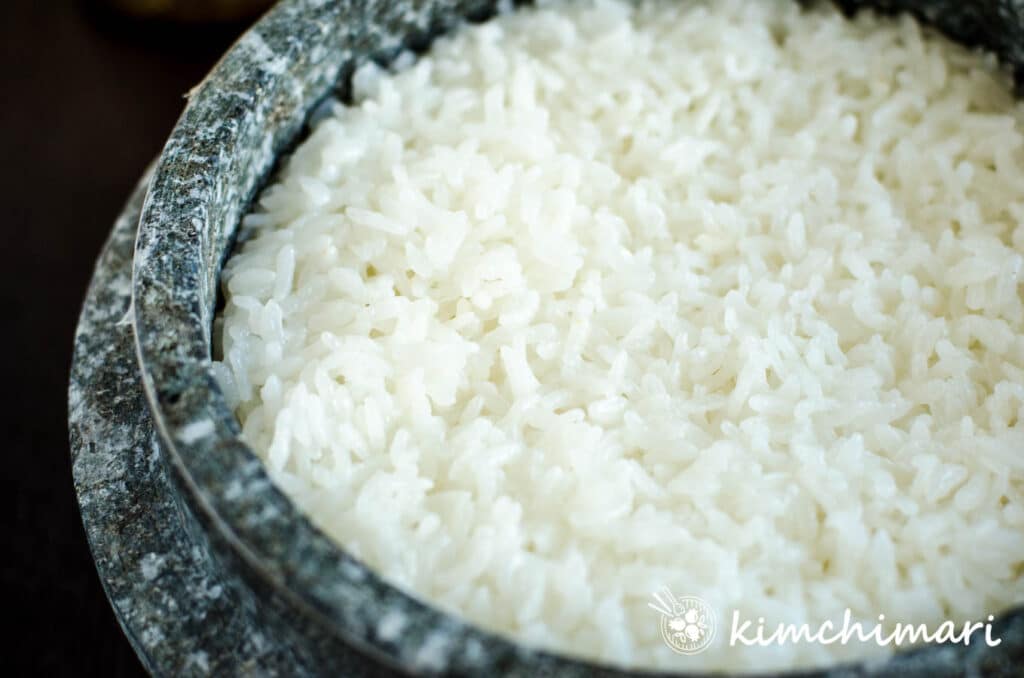
- Put soaked and drained rice (from above) in your stone pot.
- Add water. For 1 cup of rice, add 1 cup + 2 Tbs water which is around 1:1.1 (rice:water) ratio. Level and smooth out rice with your hands.
.
- Measuring water with your hands – Traditionally, Koreans measured rice water with their hands instead of cups. Most will say that the water level should come up close to your knuckles but in my experience, I find it’s about 1/2 way up from your fingertips up to your knuckles – as in the picture. Probably because again, we like more dry rice. NOTE – Water level will end up a little lower for short-grain rice because short-grain increases in volume more than medium grain.
- Cover with the lid and turn on heat to medium-high. Cook for 7 min. DO NOT OPEN the lid until it’s all cooked. If you really need to look, just take a quick peek but close it immediately.
- Lower heat to Low and simmer for 15 min.
- Turn off heat and let it sit for 5 min or longer. This is called 뜸 들인다 – Tteum deulinda. This part is important to cook the rice completely so do not open the lid sooner than 5 min.
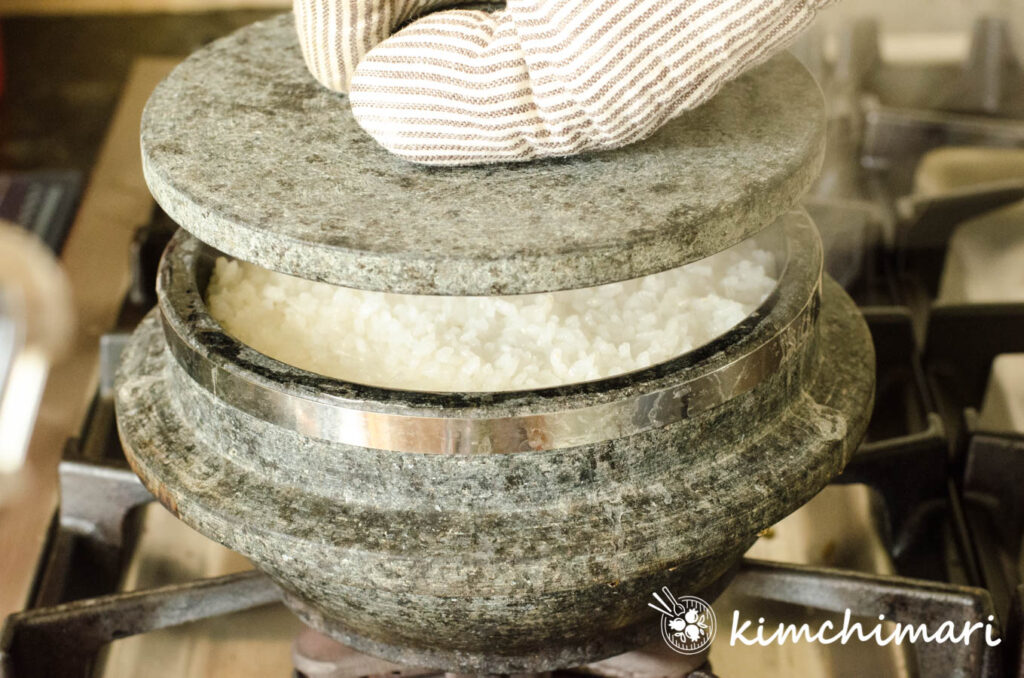
Make Nurungji (Burnt Rice)
- If you want burnt rice (Nurungji 누릉지), take out cooked rice from the pot (as much as you can) and leave rice at the bottom that are stuck to the pot. Heat the pot for 8-10 min or so (lid removed) on medium heat until it gets nicely browned.
- Enjoy Nurungji as a crunchy snack by just scraping it off from the pot.
- Or pour water on the hot pot and boil it until the rice becomes loose from the bottom. You may also have to scrap it a bit. And if you add the water while the pot is still very hot, the water will boil without any additional heat.
- Ladle it onto a bowl and enjoy it as the last course in a meal or I love having it for breakfast with some light side dishes.
How to cook Korean Rice in Pressure Rice Cooker
When using a pressure rice cooker like Cuckoo (I recommend this) or the Instant Pot, don’t soak the rice but just rinse. Soaking the rice for pressure cooking is not only NOT necessary but actually results in rice that’s too soft and mushy in my opinion. So please don’t do it.
Then follow the instructions that come with your Korean rice cooker. Baekmi 백미 means white rice and you want to choose that function. Use the 180 ml rice cup that comes with the rice cooker to measure rice, rinse 3 times and then add water to the level of the number of cups of rice you washed. This is basically following 1:1 rice to water ratio if you want to know.
Instant Pot will work similar but honestly, instant pot doesn’t do as good of a job in cooking Korean rice like the Korean rice cooker does but it works. Just use 1:1 rice to water ratio with no pre-soaking.
Our family likes Doenbap 된밥 so I usually add water up to just a little below the line. Try adding a little more or less from the cup line and see what your preference is.
Once cooked, I would recommend to not keep it in warm function more than a day.
How to store cooked rice
What is the best way to keep/store cooked rice fresh?
- Freeze rice – If you don’t want to cook fresh rice every time, a great way to have rice always at hand is to freeze rice right after it’s cooked. Especially with the pandemic, eating all the time at home, I make a big batch and then freeze individual portions in small microwavable containers (buy them here) that are specially made for freezing rice.
- Reheat frozen rice in the container in the microwave on high for 1 min 30 secs and it will taste just like it’s freshly made!
- Don’t leave your rice in ‘warm’ function too long in your electric rice cooker. Although a high-quality pressure rice cooker like Cuckoo will keep the rice fresh for days, I learned that having the rice cooker on all the time will cause the rubber seal ring in the lid to deteriorate faster, and eventually the rice will dry up and turn yellow. I learned this from a rice cooker repairman in Seoul.
Well, that’s it! Now, you know how to cook Korean white rice on the stovetop in pots and dolsot, also in the rice cooker!!
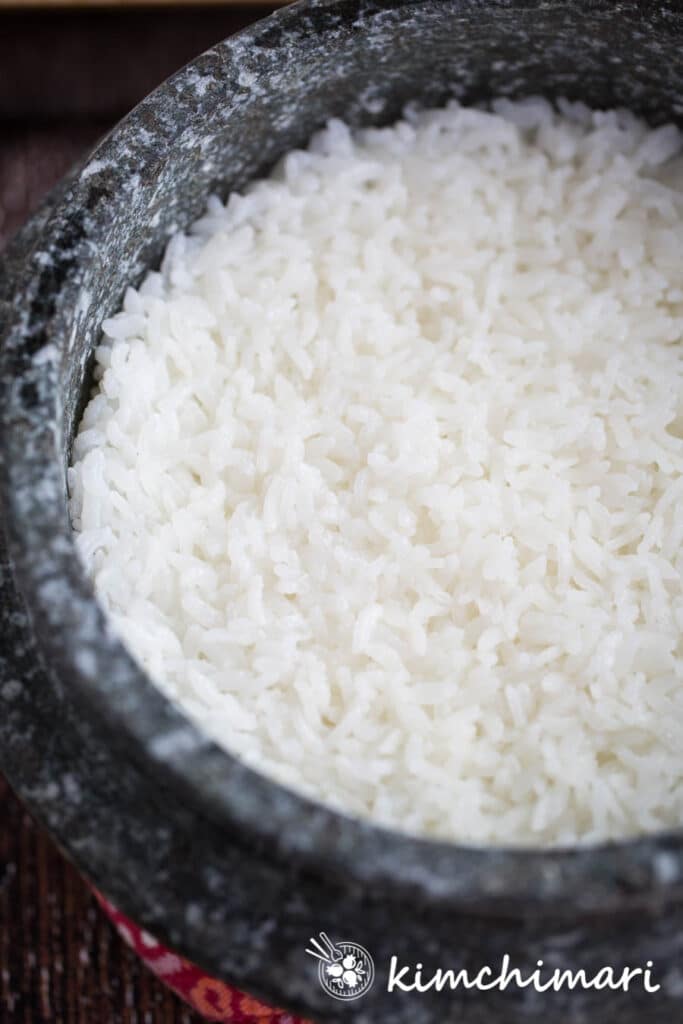
Don’t throw away rice water, use it!
Do you feel you are wasting water because you are washing it so many times? Well, you can save the rinsed water and use it for other things including watering plants. Read My 7 Uses of Rice Water for more info.
Where can I buy Stone Pot?
You can buy the Dolsot at the Korean grocery store which carry Korean kitchenware – I bought a new one recently and they were around $35. Unfortunately, amazon doesn’t have any with lids. I did find one in this online store and price seems good but I never bought from them so I don’t know..
** Please note, I’m an Amazon affiliate and I may earn a teeny bit of commission when you purchase it through my store. Thank you for your support!
FAQ on Korean Rice
Short to Medium grain rice. Different from sticky or sweet rice, jasmine or basmati rice.
Yes
I love to buy Pulmuone rice grown in California or Korean rice grown in Icheon, Korea. Other than that, yes, Koreans eat Calrose rice or any sushi rice will also be fine.
You may be served a purple or red rice at a Korean restaurant or home. It’s called Heukmi bap 흑미밥 in Korean. It is that color when you mix in some black rice (forbidden rice). The black rice when cooked with white rice, you see that beautiful purple color. You can follow my purple Korean rice recipe .
How to make Korean white rice
Ingredients
Korean Rice for stovetop
- 1 cup short or medium grain rice 1 cup = 250ml
- 280 ml water 280 ml = 1 cup + 2 Tbs
Korean Rice for pressure cookers, pressurized rice cookers
- 1 cup short or medium grain rice here 1 cup maybe 180ml rice cooker cup
- 1 cup water
Instructions
Wash Rice (do this for all methods)
- In a bowl, add rice then water and rinse by swirling the rice with your hands a few times. Drain and discard water. Add fresh water and repeat. Rinse at least 3 times.
- Soak washed rice in water for 30 minutes. Skip this step if you are cooking rice in pressurized Korean rice cooker or a pressure cooker.
- Drain.
Cooking rice on Stove Top in Stone Pot
- Put soaked and drained rice (from above) in your stone pot. Add water. For 1 cup of (before soaking) rice, add 1 cup + 2 Tbs water.
- Level out the rice a little with your hands. Check my Notes section if you want to learn how Korean moms measure water level with their hands.
- Cover with the lid and turn on heat to medium-high. Cook for 7 min. DO NOT OPEN the lid until it’s all cooked. If you really need to look, just take a quick peek but close it immediately.
- Lower heat to Low and simmer for 15 min.
- Turn off heat and let it sit for 5 min or longer. To enjoy a perfect rice, this part is important in cooking Korean rice so please don't open the rice before the 5 min.
Cooking rice on Stove Top in Pot
- Add soaked and drained rice in pot. For 1 cup rice (measured when dry), add 1 cup + 1 Tbs water to a stainless pot. Be sure to choose a pot that is deep enough so your water doesn’t boil over easily. Also, a thick-bottomed pot works best for cooking rice.
- Cover with the lid, turn on heat to medium-high and cook for 3 1/2 min to 4 min. I
- Simmer for 15 – 17 min on Low heat. Depending on how soon you lowered the heat.
- Turn off heat and let it sit for 5 min. This will make a perfectly cooked rice with no burnt rice in the bottom.**
How to make Burnt Rice (Nurungji)
- If you want burnt rice, take out as much of cooked rice from the pot as you can and leave rice at the bottom that’s sticking to the pot. Heat the pot for 8-10 min or so on medium heat until it gets nicely browned.
- Enjoy it just as it is as a crunchy snack or pour water on the hot pot and boil it until the rice becomes loose from the bottom. You may also have to scrap it a bit.
How to cook rice in Korean pressurized rice cooker or pressure cooker like Instant Pot
- When using a pressure rice cooker like Cuckoo or the Instant Pot, don't soak the rice but just rinse. Soaking the rice for pressure cooking is not only NOT necessary but actually results in rice that's too soft and mushy in my opinion. So don't do it or use less water if you soaked already.
- Follow instructions that come with your rice cooker – use their 180ml rice cup to measure rice and then add water to the level that's equal to your number of cups. This is basically following 1:1 rice to water ratio assuming you completely drained the rice before adding to pot.
- Our family likes Doenbap 된밥 so I usually add water up to just a little below the line. Try adding a little more or less from the cup line and see what your preference is.
Equipment
- pot
- bowl
Tips & Notes:
- If you want to measure the water amount with your hands, Korean usually tell you that water level should come up close to your knuckles but in my case, I find it’s about 2/3rd way up from your fingertips up to your knuckles.
- If you don’t want to cook fresh rice every time, a great way to have rice always at hand is to freeze your rice right after it’s cooked. I do this all the time, especially with the pandemic. I make a big batch and then freeze individual portions in small microwavable containers that are specifically made for freezing rice.
- Reheat frozen rice in the microwave on high for 1 min 30 secs and it will taste freshly made
- Don’t leave your rice in ‘warm’ function too long in your electric rice cooker. Although a high-quality pressure rice cooker like Cuckoo will keep the rice fresh for days, I learned that having the rice cooker on all the time will cause the rubber seal ring in the lid to deteriorate faster, and eventually the rice will dry up and turn yellow. I learned this from a rice cooker repairman in Seoul.
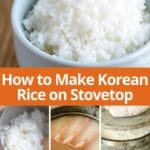
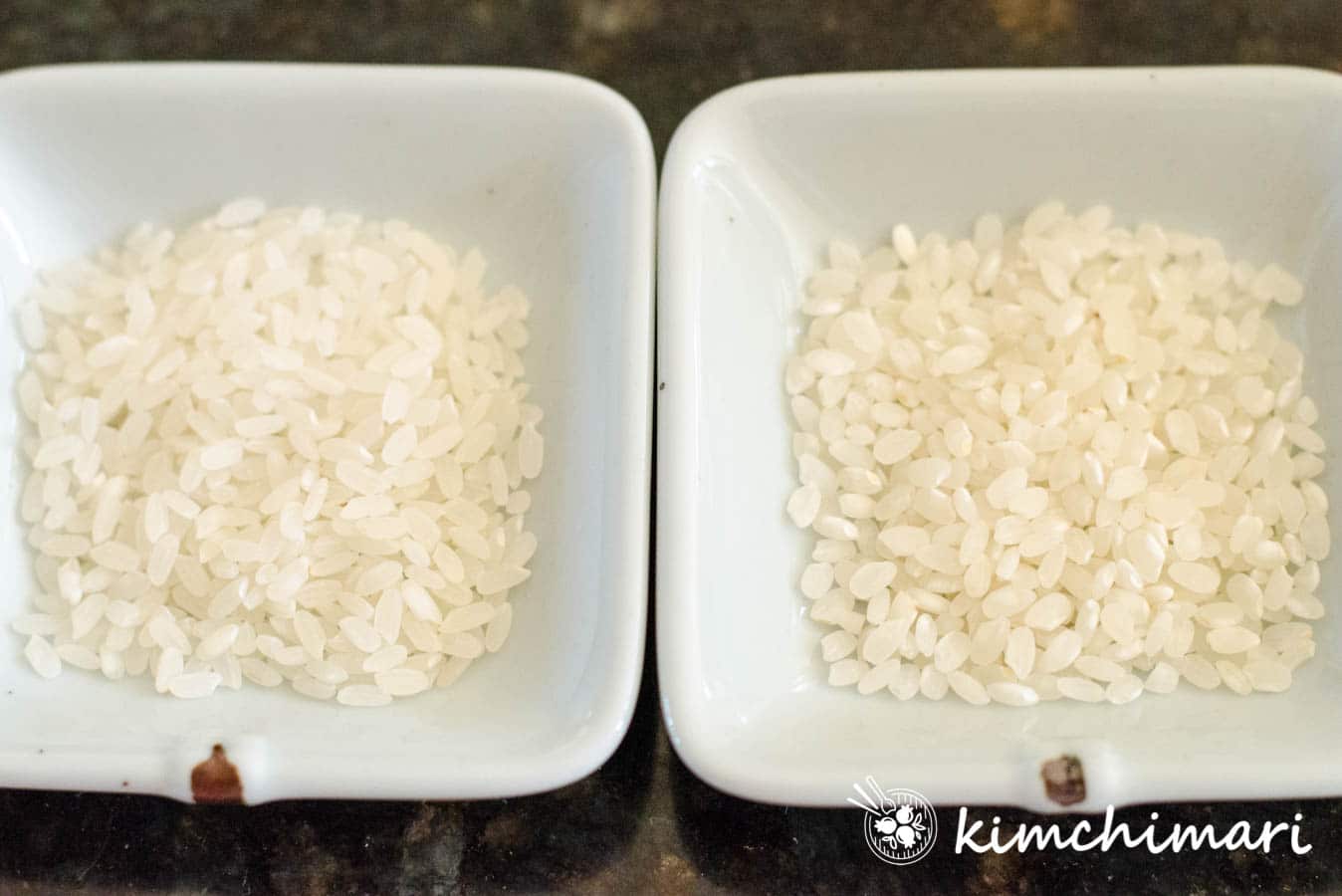

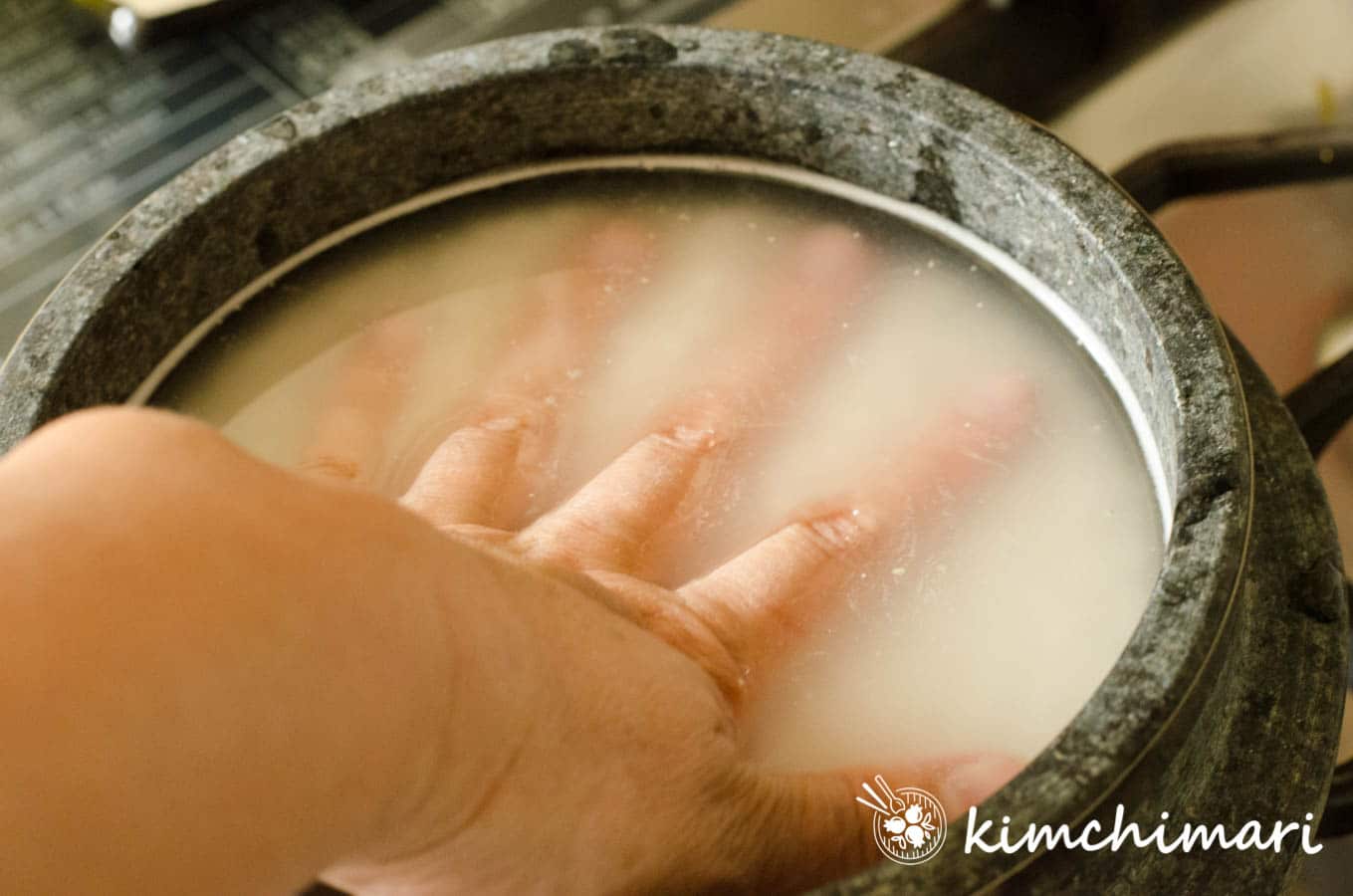 .
.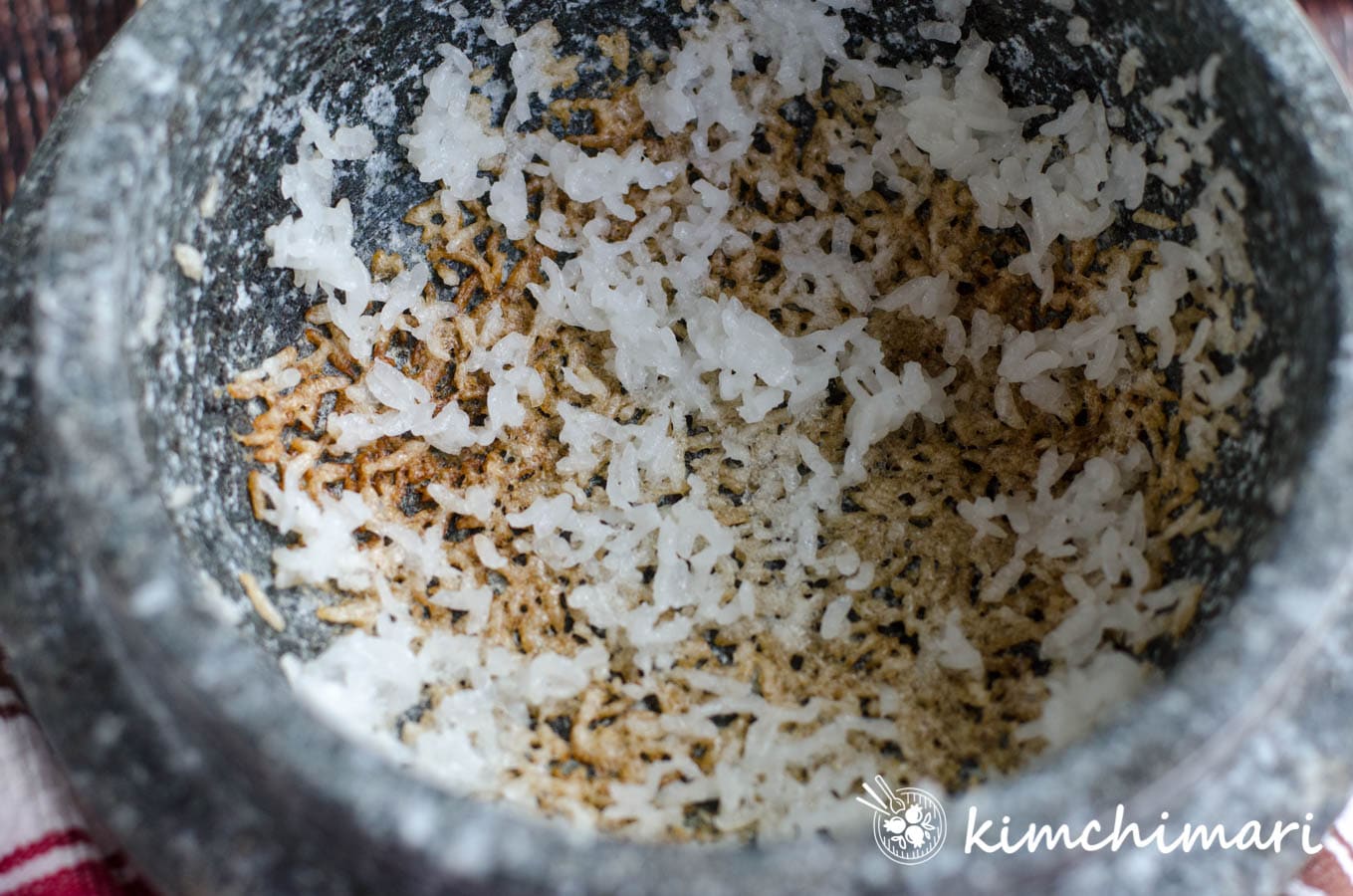
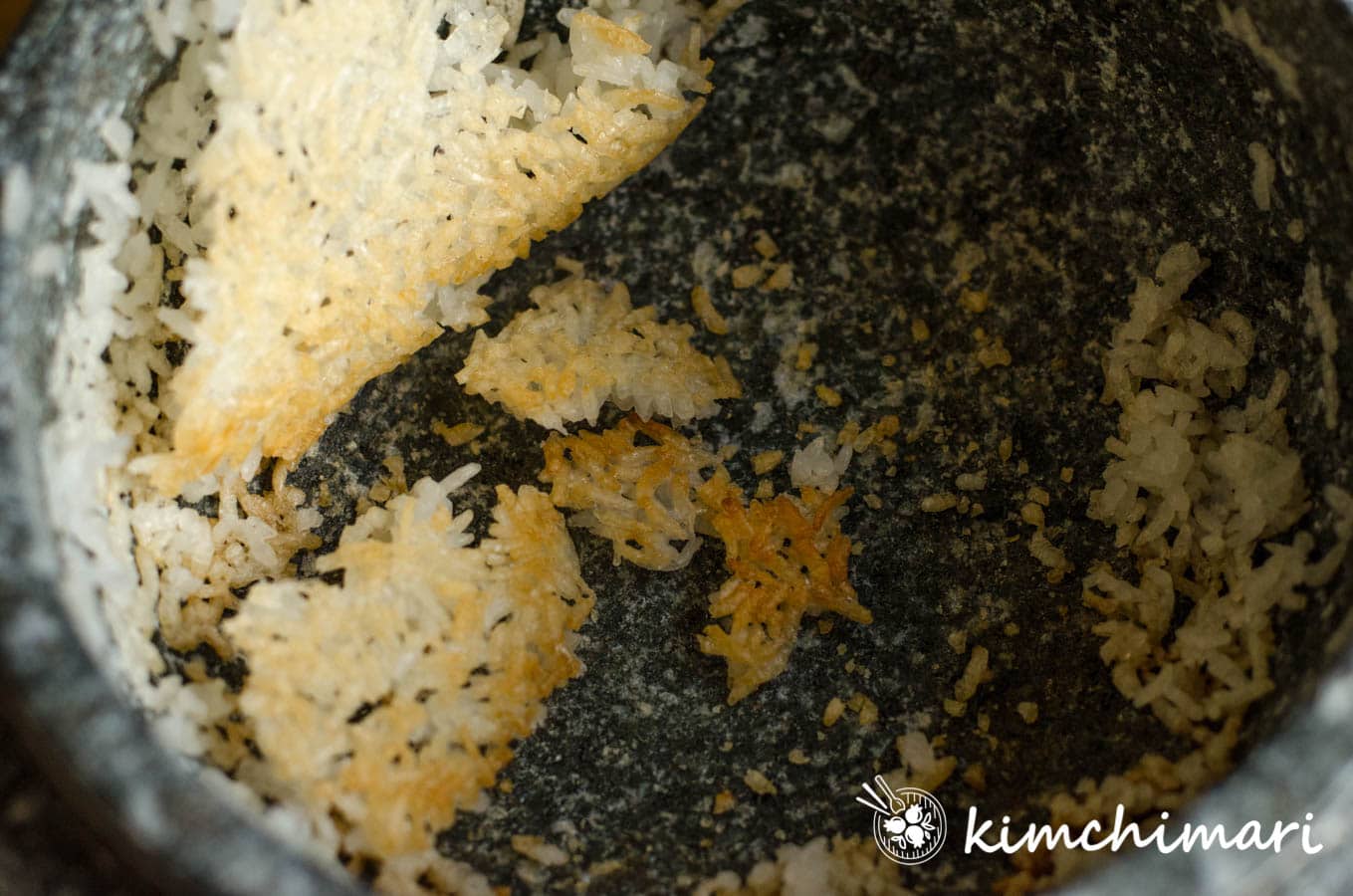
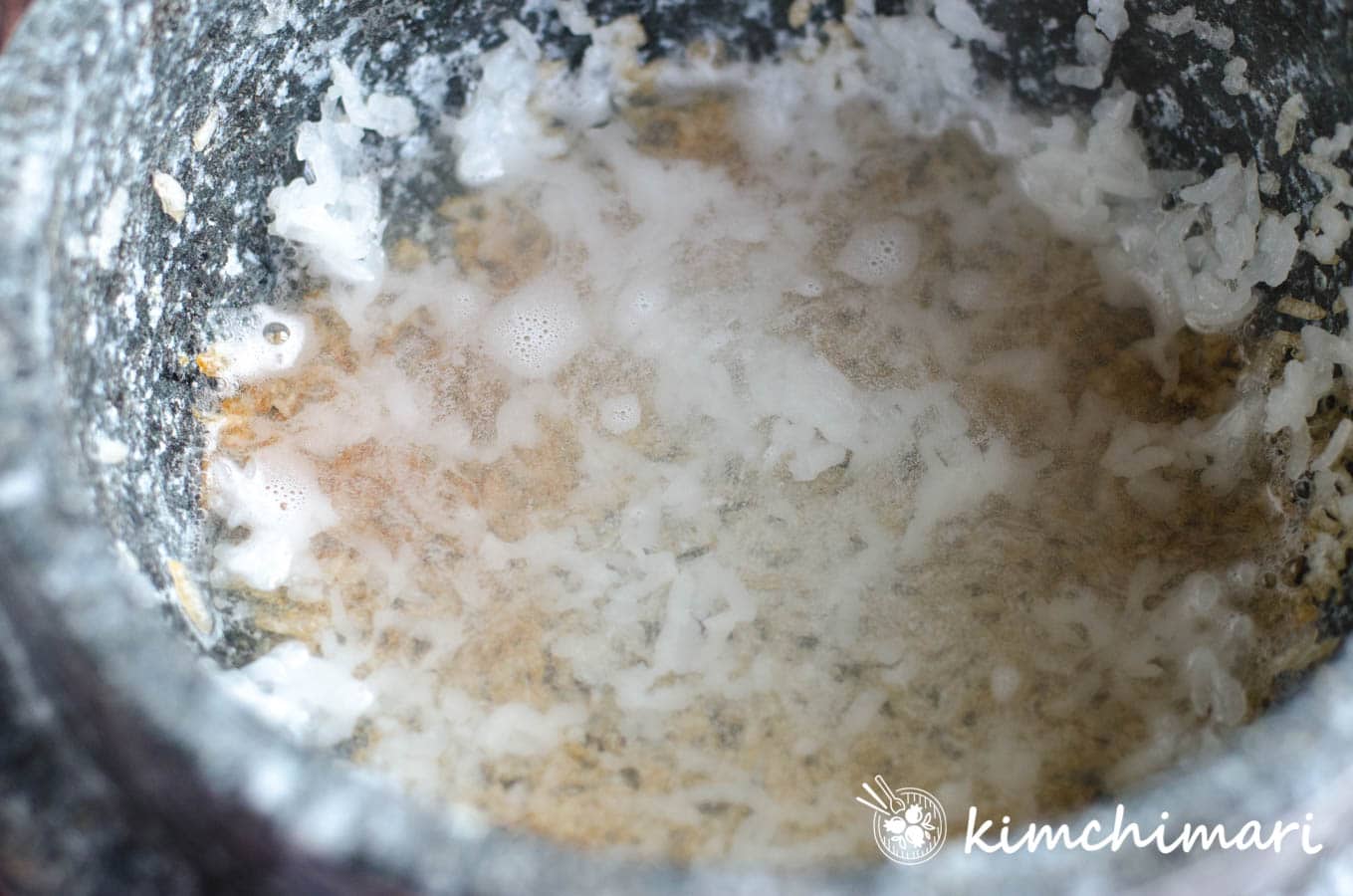

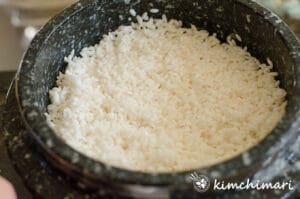

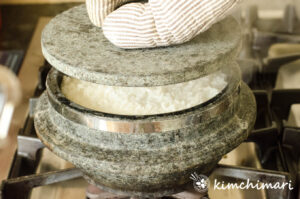

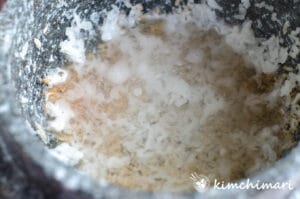
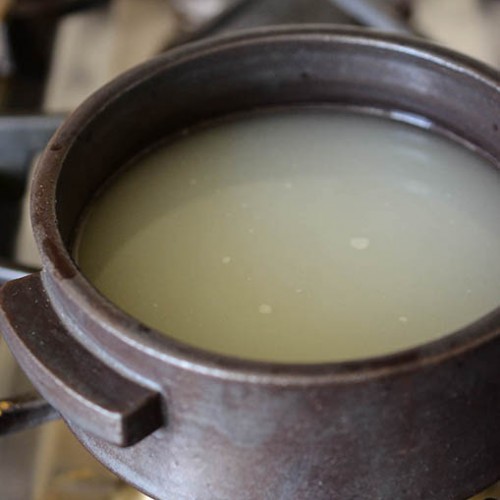
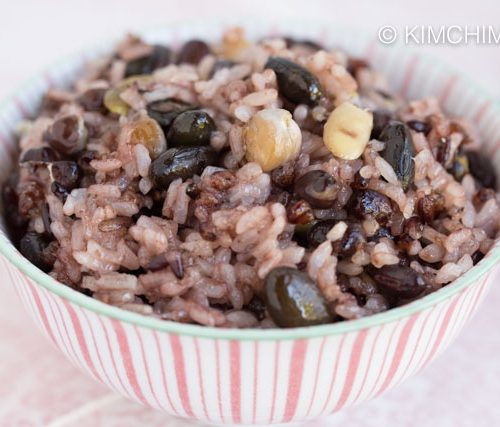
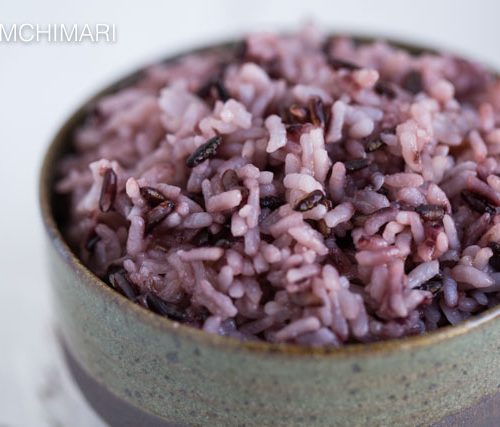

















Hi, where can I buy this blue ceramic bowl in Australia? Or online? Thank you!
Hi Jenny, So sorry, I am not sure as I don’t live in Australia.. perhaps someone else can answer.
This is really informative. Having made Thai and Filipino for years. A different process from the jasmine rice can’t wait to try it.
That’s great to hear! Thank you.
Hello Jenny,
You can purchase the stone bowl (dolsot) at Amazon. They are generally available in dark brown, but I’m sure you will be able to find something similar to what she has.
Can you use a stone pot on a flat top stove?
Not sure what you mean by flat top stove exactly but if you mean the glass stovetop, I think a stone pot can possibly work but probably not the best as it will leave scratches and also may not have the best transfer of heat from your stovetop. If it’s an induction stovetop, stoneware will not work. Hope that helps!
This is a great post. Love the history and images. I learned a lot! And now I have an excuse for when I burn my rice (a common occurrence). I will pretend I planned it for a crispy snack 🙂 My palette leans toward JinBap, I think. How is that pronounced? Is the Jin like the drink gin? And does Bap rhyme with map or am I thinking that wrong?
I’m so glad! Yup – you planned the burnt part all along.. and yes, Jinbap – Jin like ‘gin’ but the i is a bit longer – somewhere between Jean and Jin. And Bap is more like Baap, and rhymes with Pop and the B in Bap is somewhere between a P and B. Thank you for the comment!
The stove top recipe is percect. Rice came out percect on the first try! I rinsed and soaked the rice, drained, then cooked with the 1:1.1 ratio. No more mushy rice!!
Wonderful!! So happy to hear that. Thank you for the 5 stars too! 😉
Hi JinJoo,
I assume you need a gas stove to use a dolsot? Is that correct?
Hi, you can also heat it on an electric stove but just not induction. I think they sell some conducting plate that transfers heat from induction that you can use but on its own a stone pot will not heat on induction. Hope that helps!